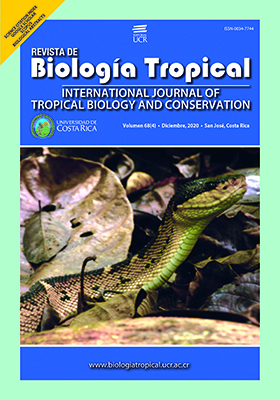Abstract
Abstract. Introduction: Alteration of the composition and structure of natural vegetation allows the invasion of species. This occurs with Pteridium esculentum subsp. arachnoideum x Pteridium esculentum subsp. campestre, which due to its growth by asexual reproduction and allelopathic effect, can quickly colonize disturbed habitat inhibiting natural succession, allowing herbaceous species to dominate and reducing tree species diversity. Objective: Evaluate the vegetation associated with the bracken P. esculentum subsp. arachnoideum x P. esculentum subsp. campestre distributed in the area called Golconda, in the Yariguíes National Park, Colombia. Methods: 15 plots of 25 m2 each were established; in each plot the vegetation composition and physiognomy were registered [growth forms, height (m) as well as vegetation cover (m2), diameter at breast height (DBH) for all trees and species abundance]; diversity probability indexes (Shannon and Simpson), percentage of species and abundance of growth forms, IVI for tree and shrub species, IVR for herbs, and the sampling effort were estimated. Results: 924 individuals belonging to 65 species were registered; they were distributed in 24 families; the richest taxa are: Melastomataceae, Asteraceae and Poaceae, which are considered frequent in disturbed areas. The areas dominated by ferns are botanically diverse, despite the dominance of species such as Ageratina cf. fastigiata, Tibouchina lindeniana, Clethra fagifolia, Coccocypselum lanceolatum and Clidemia ciliata; 30 woody and 21 herbaceous species were identified. Conclusions: Given that pioneer woody species and taxa from preserved areas of forest interiors subserve succession, this study contributes to a reevaluation of P. esculentum subsp. arachnoideum x P. esculentum subsp. campestre as an inhibitor and cause of a decrease in diversity due to its dominance.
##plugins.facebook.comentarios##

This work is licensed under a Creative Commons Attribution 4.0 International License.
Copyright (c) 2020 Astrid Lorena Castro Martínez, María Eugenia Morales Puentes, Pablo Andrés Gil Leguizamón






